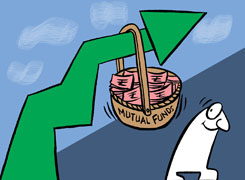50 Years Old, Investing in MF for Retirement: Which Caps?
Ramalingam Kalirajan |10870 Answers |Ask -Follow
Mutual Funds, Financial Planning Expert - Answered on Dec 23, 2024
He has an MBA in finance from the University of Madras and is a certified financial planner.
He is the director and chief financial planner at Holistic Investment, a Chennai-based firm that offers financial planning and wealth management advice.... more

I am 50 age and planning for an consistent investment in MF for the next 10 years. Which caps should I invest in large caps, large & mid caps, mid caps, small caps, multi caps and flexi caps. Should I spread across all the above categories OR invest in some specific category only. Aim is for retirement savings and monthly SIP of 35,000 Pls advise.
Balancing Across Categories
Diversifying across categories is essential for better risk-adjusted returns. However, diversification should be meaningful and goal-oriented.
Large-Cap Funds
These funds invest in established, blue-chip companies with stable returns.
They are ideal for consistent growth and lower risk.
Allocating around 30% of your investment here ensures portfolio stability.
Large & Mid-Cap Funds
These funds combine large-cap stability with mid-cap growth potential.
They are suitable for investors seeking moderate risk and higher returns.
Allocating 20% to this category provides balance and growth.
Mid-Cap Funds
Mid-cap funds focus on emerging companies with significant growth potential.
These funds carry moderate-to-high risk but offer better returns over 7-10 years.
Allocate around 15% to mid-cap funds for growth.
Small-Cap Funds
Small-cap funds invest in companies with high growth potential but are highly volatile.
They are suitable for aggressive investors with a long horizon.
Limit exposure to 10%, given the higher risk involved.
Multi-Cap Funds
Multi-cap funds invest across large, mid, and small-cap companies.
They provide diversification within a single fund and reduce portfolio overlap.
Allocate around 15% to this category for balanced returns.
Flexi-Cap Funds
Flexi-cap funds allow fund managers to switch allocations across market caps.
They adapt to market conditions, offering flexibility and balanced growth.
Allocate the remaining 10% to flexi-cap funds for dynamic management.
Considerations for Effective Investment
SIP Advantage
SIPs reduce the risk of market timing through rupee cost averaging.
They build discipline in investments and accumulate wealth systematically.
Risk Management
Equity funds are subject to market fluctuations, especially mid and small-cap funds.
Diversify wisely to manage risks and reduce dependency on a single category.
Tax Implications
LTCG above Rs. 1.25 lakh is taxed at 12.5%.
STCG is taxed at 20%, impacting short-term gains.
Plan redemptions to minimise tax liabilities.
Avoiding Index and Direct Funds
Drawbacks of Index Funds
Index funds lack active management and cannot outperform markets.
They mirror market trends and may underperform during volatility.
Actively managed funds can optimise returns through stock selection.
Disadvantages of Direct Plans
Direct plans lack the guidance of a Certified Financial Planner (CFP).
CFPs provide tailored strategies and portfolio reviews.
Investing through regular plans ensures professional monitoring and better outcomes.
Benefits of Professional Guidance
A Certified Financial Planner ensures optimal asset allocation.
They align investments with your retirement goals.
Periodic reviews help adjust to market conditions and life changes.
Finally
Spread your investments wisely across categories to balance growth and stability. Large-cap and large & mid-cap funds should form the core of your portfolio. Mid-cap and small-cap funds offer growth but require controlled exposure. Multi-cap and flexi-cap funds provide flexibility and diversification.
Invest consistently and review your portfolio annually. Seek the guidance of a Certified Financial Planner for customised strategies and disciplined execution.
Best Regards,
K. Ramalingam, MBA, CFP,
Chief Financial Planner,
www.holisticinvestment.in
https://www.youtube.com/@HolisticInvestment
You may like to see similar questions and answers below
Vivek Lala |323 Answers |Ask -Follow
Tax, MF Expert - Answered on Oct 09, 2023
Ramalingam Kalirajan |10870 Answers |Ask -Follow
Mutual Funds, Financial Planning Expert - Answered on May 09, 2024
Ramalingam Kalirajan |10870 Answers |Ask -Follow
Mutual Funds, Financial Planning Expert - Answered on Apr 23, 2024
Ulhas Joshi |280 Answers |Ask -Follow
Mutual Fund Expert - Answered on Jun 11, 2024
Ramalingam Kalirajan |10870 Answers |Ask -Follow
Mutual Funds, Financial Planning Expert - Answered on Jul 01, 2024
Dr Shyam Jamalabad |107 Answers |Ask -Follow
Dentist - Answered on Dec 05, 2025
Dr Shyam Jamalabad |107 Answers |Ask -Follow
Dentist - Answered on Dec 05, 2025
Dr Dipankar Dutta |1836 Answers |Ask -Follow
Tech Careers and Skill Development Expert - Answered on Dec 05, 2025
Ulhas Joshi |280 Answers |Ask -Follow
Mutual Fund Expert - Answered on Dec 05, 2025
Dr Dipankar Dutta |1836 Answers |Ask -Follow
Tech Careers and Skill Development Expert - Answered on Dec 04, 2025
Ravi Mittal |676 Answers |Ask -Follow
Dating, Relationships Expert - Answered on Dec 04, 2025
Anu Krishna |1745 Answers |Ask -Follow
Relationships Expert, Mind Coach - Answered on Dec 04, 2025
Anu Krishna |1745 Answers |Ask -Follow
Relationships Expert, Mind Coach - Answered on Dec 04, 2025
Mayank Chandel |2562 Answers |Ask -Follow
IIT-JEE, NEET-UG, SAT, CLAT, CA, CS Exam Expert - Answered on Dec 04, 2025
Mayank Chandel |2562 Answers |Ask -Follow
IIT-JEE, NEET-UG, SAT, CLAT, CA, CS Exam Expert - Answered on Dec 04, 2025


























